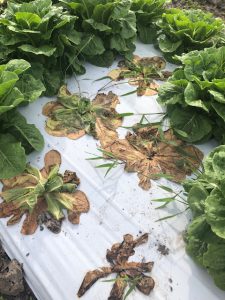Tiny little tan sclerotium, oh my!

Southern blight, or Sclerotrium rolfsii is a soilborne fungus that has many hundreds of hosts. The fungus can be spread through movement of infested soil and plant debris, on infected plants, in contaminated irrigation water, and through use of contaminated tools. Ideal temperatures for mycelial growth ranges from 46°F–104°F. The optimal temperature for sclerotia production is between 81°F–95°F. The pathogen favors water-saturated soils with high temperatures.

The fungus infects lower stems near or at the soil surface. It may infect any part of a susceptible plant. A girdling lesion will begin to infect the crown and stems, as defoliation occurs. Crown collapse if often observed in leafy greens. Thick mats of white mycelia may grow from infected tissue, radiating from the plant onto the soil surface. Sclerotia develop on infected tissue and soil. It ranges in color from light tan to dark reddish-brown to black.

Sclerotia can be killed in four to six hours at 122°F. Covering moistened soil with clear polyethylene sheets during the summer season. This can reduce the number of viable sclerotia. The use of soil fumigants are the most practical means to treat fields for a number of soil-borne pathogens. They must be applied days to weeks before planting. Preplant fungicides, such as captan and pentachloronitrobenzene (PCNB), are effective in reducing disease severity.
Contact your local county agricultural extension agent for assistance with southern blight in vegetables. You can also review our UF/IFAS article on Integrated Pest Management of Southern Blight in Vegetable Production.
 0
0
